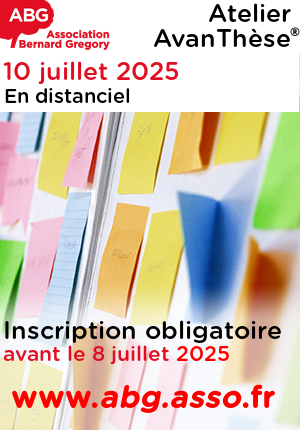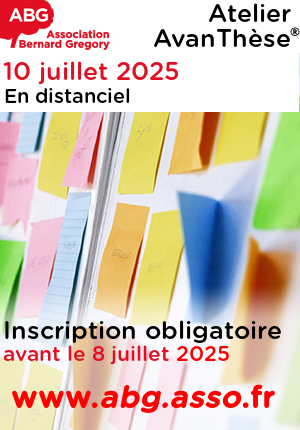Etude de la physique des moments orbitaux avec des antiferromagnétiques dans la gamme sub-THz // Sub-teraHertz Investigation of orbital momentum physics with antiferromagnets
|
ABG-132153
ADUM-66215 |
Sujet de Thèse | |
| 23/05/2025 |
Université Grenoble Alpes
Grenoble cedex 9 - Auvergne-Rhône-Alpes - France
Etude de la physique des moments orbitaux avec des antiferromagnétiques dans la gamme sub-THz // Sub-teraHertz Investigation of orbital momentum physics with antiferromagnets
- Physique
Electronique de spin antiferromagnétique, oxydes magnétiques, physique teraHertz, orbitronique
Antiferromagnetic spintronics, Magnetic Oxides, TeraHertz Physics, Orbitronics
Antiferromagnetic spintronics, Magnetic Oxides, TeraHertz Physics, Orbitronics
Description du sujet
Les dernières années ont été marquées par un regain d'intérêt pour les couplages mutuels entre différentes excitations de la matière condensée (photons, phonons, magnons, etc.), dans le but de construire des dispositifs hybrides dotés de nouvelles fonctionnalités. Ceux-ci peuvent notamment être exploités en électronique de spin ou en ingénierie quantique. Dans ce contexte, le transfert de moment angulaire entre photons, phonons, magnons et électrons dans les antiferromagnétiques est un vaste sujet de recherche fondamentale qui pourrait ouvrir la voie à la génération, à la manipulation et à l'interconversion électronique d'ondes de spin chirales dans la gamme des fréquences sub-THz à THz. La dynamique THz du paramètre d'ordre antiferromagnétique provient des interactions d'échange interne entre les sous-réseaux de spin (~ 100 T), qui sont supérieurs de plusieurs ordres de grandeur aux champs internes impliqués dans la dynamique GHz des matériaux ferromagnétiques. Les progrès considérables de ces dernières années dans la synthèse de films épitaxiés ultraminces (<100 nm) d'isolants antiferromagnétiques permettent une nouvelle approche expérimentale dans ce domaine de recherche. Tandis que les applications des antiferromagnétiques à l'électronique conventionnelle (à température ambiante) sont maintenant bien étudiées, il reste un potentiel largement inexploré pour transformer ces systèmes en dispositifs compacts et cryogéniques fonctionnant dans la gamme THz. Ils présenteraient une immunité renforcée aux fluctuations thermiques, et pourraient ainsi fonctionner à des températures de quelques K, au lieu de la gamme habituelle des mK. Cette étude a ainsi le potentiel de façonner de futures technologies habilitantes quantiques au moyen de dispositifs fonctionnant dans cette gamme des fréquences sub-THz à THz.
Le cœur de ce travail de thèse consistera à explorer les mécanismes fondamentaux des différents couplages avec les magnons ferrimagnétiques et antiferromagnétiques dans la gamme des fréquences sub-THz à THz. Le projet couvrira plusieurs classes d'oxydes magnétiques, synthétisés à Grenoble dans le cadre de ce travail doctoral, ou disponibles via des collaborations externes. Cette thèse s'appuiera sur le savoir-faire complet disponible dans l'environnement grenoblois, couvrant notamment les matériaux, la spintronique, les champs intenses et la spectroscopie THz. Ce projet est une collaboration entre NEEL (W. Legrand, L. Ranno) [1], SPINTEC (V. Baltz et U. Ebels) [2,3] et le LNCMI (A.-L. Barra) [4], en lien avec un réseau de collaborations nationales et internationales [5]. Les techniques développées couvriront la synthèse d'oxydes, la fabrication en salle blanche, la caractérisation magnétique à l'échelle nanométrique et à des températures cryogéniques, ainsi que des expériences sous champs magnétiques intenses (15 T) et à des fréquences élevées (600 GHz), développées au LNCMI.
------------------------------------------------------------------------------------------------------------------------------------------------------------------------
------------------------------------------------------------------------------------------------------------------------------------------------------------------------
The recent years have witnessed a renewed interest in the mutual coupling of condensed-matter excitations of different nature (incl. photons, phonons, magnons, etc.), aiming to build hybrid devices with new functionalities to be leveraged, for instance, in spintronics or in quantum engineering. In this context, the transfer of angular momentum between photons, phonons, magnons and electrons in antiferromagnets is a vast subject of fundamental research that could pave the way for the generation, manipulation and electrical conversion of chiral antiferromagnetic spin waves in the sub-THz to THz frequency range. The THz dynamics of the antiferromagnetic order parameter is directly related to the internal exchange interactions between the spin sub-lattices (~100T), which is several orders of magnitude larger than the internal fields involved in the GHz dynamics of ferromagnetic materials. Our experimental approach is supported by the tremendous progress made over the recent years in the synthesis of ultrathin (<100 nm) epitaxial films of antiferromagnetic insulators. While applications of antiferromagnets to room-temperature common electronics are now thoroughly investigated, there remains a largely unexplored potential for turning them into compact, cryogenic devices operating in the THz. They would present superior immunity to thermal fluctuations and thus be able to operate at temperatures of a few K, instead of the mK range. This investigation has potential to shape future key enabling technologies with quantum devices operating in the sub-THz to THz frequency range.
The core of this Ph.D. work will be to explore the fundamental coupling mechanisms of ferrimagnetic and antiferromagnetic magnons in the sub-THz to THz frequency range. The project will span several classes of magnetic oxides to be grown in Grenoble as part of this Ph.D. work, and also obtained through external collaborations. You will benefit from the holistic knowhow in Grenoble covering from materials and spintronics to high fields and THz spectroscopies, in NEEL (W. Legrand, L. Ranno) [1], SPINTEC (V. Baltz and U. Ebels) [2,3] and LNCMI (A.-L. Barra) [4], and from national and international collaborations [5]. You will work with state-of-the-art techniques for oxide synthesis, cleanroom fabrication, characterization at the nanoscale under cryogenic temperatures, as well as experiments under strong magnetic fields (15 T) and large frequencies (600 GHz) developed in LNCMI.
------------------------------------------------------------------------------------------------------------------------------------------------------------------------
------------------------------------------------------------------------------------------------------------------------------------------------------------------------
Début de la thèse : 01/10/2025
WEB : https://neel.cnrs.fr
Le cœur de ce travail de thèse consistera à explorer les mécanismes fondamentaux des différents couplages avec les magnons ferrimagnétiques et antiferromagnétiques dans la gamme des fréquences sub-THz à THz. Le projet couvrira plusieurs classes d'oxydes magnétiques, synthétisés à Grenoble dans le cadre de ce travail doctoral, ou disponibles via des collaborations externes. Cette thèse s'appuiera sur le savoir-faire complet disponible dans l'environnement grenoblois, couvrant notamment les matériaux, la spintronique, les champs intenses et la spectroscopie THz. Ce projet est une collaboration entre NEEL (W. Legrand, L. Ranno) [1], SPINTEC (V. Baltz et U. Ebels) [2,3] et le LNCMI (A.-L. Barra) [4], en lien avec un réseau de collaborations nationales et internationales [5]. Les techniques développées couvriront la synthèse d'oxydes, la fabrication en salle blanche, la caractérisation magnétique à l'échelle nanométrique et à des températures cryogéniques, ainsi que des expériences sous champs magnétiques intenses (15 T) et à des fréquences élevées (600 GHz), développées au LNCMI.
------------------------------------------------------------------------------------------------------------------------------------------------------------------------
------------------------------------------------------------------------------------------------------------------------------------------------------------------------
The recent years have witnessed a renewed interest in the mutual coupling of condensed-matter excitations of different nature (incl. photons, phonons, magnons, etc.), aiming to build hybrid devices with new functionalities to be leveraged, for instance, in spintronics or in quantum engineering. In this context, the transfer of angular momentum between photons, phonons, magnons and electrons in antiferromagnets is a vast subject of fundamental research that could pave the way for the generation, manipulation and electrical conversion of chiral antiferromagnetic spin waves in the sub-THz to THz frequency range. The THz dynamics of the antiferromagnetic order parameter is directly related to the internal exchange interactions between the spin sub-lattices (~100T), which is several orders of magnitude larger than the internal fields involved in the GHz dynamics of ferromagnetic materials. Our experimental approach is supported by the tremendous progress made over the recent years in the synthesis of ultrathin (<100 nm) epitaxial films of antiferromagnetic insulators. While applications of antiferromagnets to room-temperature common electronics are now thoroughly investigated, there remains a largely unexplored potential for turning them into compact, cryogenic devices operating in the THz. They would present superior immunity to thermal fluctuations and thus be able to operate at temperatures of a few K, instead of the mK range. This investigation has potential to shape future key enabling technologies with quantum devices operating in the sub-THz to THz frequency range.
The core of this Ph.D. work will be to explore the fundamental coupling mechanisms of ferrimagnetic and antiferromagnetic magnons in the sub-THz to THz frequency range. The project will span several classes of magnetic oxides to be grown in Grenoble as part of this Ph.D. work, and also obtained through external collaborations. You will benefit from the holistic knowhow in Grenoble covering from materials and spintronics to high fields and THz spectroscopies, in NEEL (W. Legrand, L. Ranno) [1], SPINTEC (V. Baltz and U. Ebels) [2,3] and LNCMI (A.-L. Barra) [4], and from national and international collaborations [5]. You will work with state-of-the-art techniques for oxide synthesis, cleanroom fabrication, characterization at the nanoscale under cryogenic temperatures, as well as experiments under strong magnetic fields (15 T) and large frequencies (600 GHz) developed in LNCMI.
------------------------------------------------------------------------------------------------------------------------------------------------------------------------
------------------------------------------------------------------------------------------------------------------------------------------------------------------------
Début de la thèse : 01/10/2025
WEB : https://neel.cnrs.fr
Nature du financement
Précisions sur le financement
Enseignement supérieur
Présentation établissement et labo d'accueil
Université Grenoble Alpes
Etablissement délivrant le doctorat
Université Grenoble Alpes
Ecole doctorale
47 PHYS - Physique
Profil du candidat
Un diplôme de master validé au plus tard à la date d'entrée en doctorat est exigé, ainsi qu'un excellent dossier académique. Les candidats doivent être titulaires d'un diplôme en physique, disposer d'aptitudes expérimentales et de programmation, être motivés par le travail en équipe et la communication dans un cadre scientifique, et s'intéresser à la physique expérimentale, à la science des matériaux et à la physique de l'état solide, avec une appétence pour l'instrumentation de pointe.
A Master's degree awarded at the latest by the starting date is demanded, and an excellent academic record is mandatory. Applicants should have a degree in Physics, good practical and coding skills, a commitment to teamwork and scientific communication, and the will to pursue work involving experimental physics, material science, and solid-state physics with a commitment to advanced instrumentation.
A Master's degree awarded at the latest by the starting date is demanded, and an excellent academic record is mandatory. Applicants should have a degree in Physics, good practical and coding skills, a commitment to teamwork and scientific communication, and the will to pursue work involving experimental physics, material science, and solid-state physics with a commitment to advanced instrumentation.
20/06/2025
Postuler
Fermer
Vous avez déjà un compte ?
Nouvel utilisateur ?
Besoin d'informations sur l'ABG ?
Vous souhaitez recevoir nos infolettres ?
Découvrez nos adhérents
 Laboratoire National de Métrologie et d'Essais - LNE
Laboratoire National de Métrologie et d'Essais - LNE  ASNR - Autorité de sûreté nucléaire et de radioprotection - Siège
ASNR - Autorité de sûreté nucléaire et de radioprotection - Siège  Nokia Bell Labs France
Nokia Bell Labs France  Ifremer
Ifremer  PhDOOC
PhDOOC  Institut Sup'biotech de Paris
Institut Sup'biotech de Paris  TotalEnergies
TotalEnergies  Généthon
Généthon  Groupe AFNOR - Association française de normalisation
Groupe AFNOR - Association française de normalisation  Aérocentre, Pôle d'excellence régional
Aérocentre, Pôle d'excellence régional  CASDEN
CASDEN  SUEZ
SUEZ  Tecknowmetrix
Tecknowmetrix  ANRT
ANRT  MabDesign
MabDesign  ONERA - The French Aerospace Lab
ONERA - The French Aerospace Lab  MabDesign
MabDesign  ADEME
ADEME  CESI
CESI







